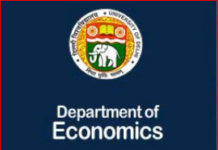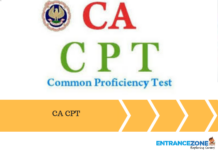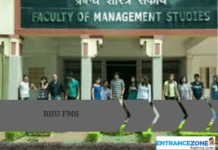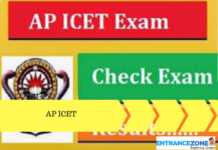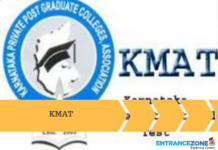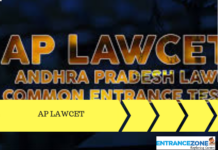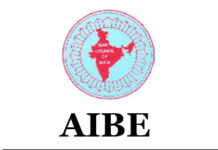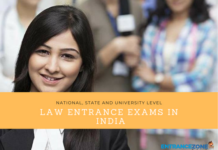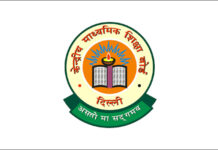NDA Syllabus 2023 is available here in pdf format for free download. Students can also download the NDA Syllabus in Hindi/ English along with the Exam Pattern online. NDA (National Defence Academy) syllabus is organized into the Mathematics section and General Ability Test section. Candidates can find all topics related to the NDA exam syllabus in the 11th and 12th NCERT books. Also, the difficulty level of the NDA Entrance Exam question matches with Class 12th level. Candidates can check the marking scheme and NDA Syllabus 2023 available on this page below.
Admission Open 2023
- Top University & Colleges Official Links, Application & Scholarship Forms.
NDA Syllabus 2023
Contains
Candidates have to cover the following topics to qualify the NDA entrance exam to select as cadets for The Indian Air Force Services, The Indian Navy, and The Indian Army.
Paper-I(Mathematics Section):
As per NDA 2020 pattern, this mathematics section is a total of 300 marks and carries 120 questions. All questions based on NCERT Books of 11th and 12th. Candidates are required to pass in this paper. To score a valid marks in this paper, candidates can follow NDA Syllabus 2023 given below:
Subscribe to Get Updated Information about NDA Syllabus 2023: Written Test Syllabus & Interview Questions - Admissions
| Topics | Important Sub -Topics |
| Algebra | Sets, De-morgan Laws, Relation, Cartesian Products, Number Systems, Sequence & Series, Quadratic Equation, Linear inequation of two variables, Binomial Theorem, Logarithms, Permutation and Combination |
| Matrices | Types of Matrices, Operation on Matrices, Properties of Matrix, Adjoint and Inverse of square Matrix, Determinant Matrix, Linear equation in two or three variables by matrix method & Cramer’s rule |
| Trigonometry | Angles & their measures, Ratios, Identities |
| Trigonometry | Inverse Trigonometric Functions, Sum & Difference, Multiple & Submultiple Angles, Application in Height & Distance, properties of Triangles |
| Analytical Geometry( 2 & 3 Dimensions) | Rectangular Cartesian Coordinate system, Distance of a point from a line, Equation of a circle in standard and general form, Distance formula, Equation of a line in various forms, angle between two lines, Direction Cosines and direction ratios, equation of a plane and a line in various forms, angle between two lines and the angle between two planes, Standard forms of parabola, ellipse and hyperbola, distance between two points, Direction Cosines and direction ratios, Eccentricity and axis of a conic, Point in a three-dimensional space, Equation two points, Equation of a sphere. |
| Differential Calculus | Concept of a real-valued function–domain, range and graph of a function, Composite functions, one to one, onto and inverse functions, Derivative of function at a point, geometrical and physical interpretation of a derivative—applications, Composite functions, one to one, onto and inverse functions, Notion of limit, Standard limits—examples. Continuity of functions—examples, derivative of a function to another function, derivative of a composite function, algebraic operations on continuous functions, Derivatives of sum, product and quotient of functions, Application of derivatives in problems of maxima and minima, Second order derivatives. Increasing and decreasing functions. |
| Integral Calculus | Evaluation of definite integrals—determination of areas of plane regions bounded by curves—applications, Integration as inverse of differentiation, integration by substitution and by parts, standard integrals involving algebraic expressions, trigonometric, exponential and hyperbolic functions. |
| Differential Equations | Definition of order and degree of a differential equation, General and particular solution of a differential equation, formation of a differential equation by examples, solution of first order and first-degree differential equations of various types—examples. Application in problems of growth and decay |
| Vector Algebra | Vectors in two and three dimensions, magnitude and direction of a vector, Vector product or cross product of two vectors, Applications—work done by a force and moment of a force and in geometrical problems, Unit and null vectors, addition of vectors, scalar multiplication of a vector, scalar product or dot product of two vectors. |
| Statistics | Classification of data, Frequency distribution, cumulative frequency distribution—examples, Variance and standard deviation—determination and comparison, Graphical representation—Histogram, Pie Chart, frequency polygon— examples, Correlation and regression, Measures of Central tendency—Mean, median and mode. |
| Probability | Random experiment, outcomes and associated sample space, events, mutually exclusive and exhaustive events, impossible and certain events, Random variable as function on a sample space, Union and Intersection of events. Complementary, elementary and composite events, Binomial distribution, examples of random experiments giving rise to Binomial distribution, Definition of probability—classical and statistical—examples, Elementary theorems on probability—simple problems, Conditional probability, Bayes’ theorem—simple problems |
Candidates can keep visiting this page for the latest updates for NDA Syllabus 2023.
Paper-II(General Ability Test Section):
As per NDA 2020 pattern, this mathematics section is a total of 600 marks and carries 150 questions in two parts such Part ’A’ includes English and Part ‘B’ covering the 6 subjects namely Physics, Social Studies, General Science, Geography, Chemistry & Current Events. All questions based on NCERT Books of 11th and 12th. Candidates are required to pass in this GAT paper. To score a valid marks in this paper, candidates can refer syllabus given below:
| Sections | Important Topics |
| English | Grammar Usage, Comprehension & Cohesion, vocabulary |
| Physics | Physical Properties and States of Matter, Mass, Density and Specific Gravity, Volume, Weight, Principle of Archimedes, Pressure Barometer, Motion, Laws of Motions, Velocity & Acceleration, Forces & Momentum, State & Equilibrium, Parallelogram of Forces, Work, Power & Energy, Measurement of Temperature, Heats and modes of transfer, Sound waves and its properties, Musical Instruments, Light, Optics, Magnets and properties, Types of Magnets, Current, X-rays, |
| General Working: Simple Pendulum, Simple Pulleys, Siphon, Mariner’s Compass; Lightning Conductors, Safety Fuses, evers, Balloon, Pumps, Hydrometer, Periscope, Telescope, Microscope, Telegraphs, Telephone, Pressure Cooker, Thermos Flask, Gramophone. | |
| General Science | Difference between the living and nonliving, Growth and Reproduction in Plants and Animals, Basis of Life—Cells, Protoplasms and Tissues, Common Epidemics, their causes and prevention, Elementary knowledge of Human Body and its important organs, About food & its properties, Eclipses. Achievements of Eminent Scientists, The Solar System Meteors and Comets. |
| Current Events | Prominent personalities—both Indian and International including those connected with cultural activities and sports, knowledge of Important events that have happened in India in recent years, Current important world events. |
| Chemistry | Physical and Chemical changes, Properties of Air and Water, Elements, Mixtures and Compounds, Law of Chemical Combination (excluding problems), Symbols, Formulae and simple Chemical Equations,
Preparation and Properties of Hydrogen, Oxygen, Acids, bases and salts. Carbon—different forms. Fertilizers—Natural and Artificial, Oxygen, Nitrogen and Carbon Dioxide, Oxidation and Reduction, Carbon—different forms. Fertilizers—Natural and Artificial, Elementary ideas about the structure of Atom, Atomic Equivalent and Molecular Weights, Valency, Material used in the preparation of substances like Soap, Safety Matches, GunPowder, Glass, Ink, Paper, Cement, and Paints, |
| Geography | The Earth, its shape and size, Concept of time, Rocks and their classification, Latitudes and Longitudes, Weathering—Mechanical and Chemical, Earthquakes and Volcanoes, International Date Line. Movements of Earth and their effects. Origin of Earth, Regional Geography of India—Climate, Natural vegetation, Important Sea ports and main sea, land and air routes of India, Mineral and Power resources; location and distribution of agricultural and Industrial activities, Main items of Imports and Exports of India. Ocean Currents and Tides Atmosphere and its composition, Types of Climate, Major Natural regions of the World, Temperature and Atmospheric Pressure, Planetary Winds, Cyclones and Anticyclones, Condensation and Precipitation, Humidity. |
| Social Studies | A broad survey of Indian History, with emphasis on Civilisation and Culture.
Freedom Movement in India, Basic knowledge of Five Year Plans of India. Panchayati Raj, Co-operatives and Community Development, Elementary study of Indian Constitution and Administration, Bhoodan, Sarvodaya, National Integration and Welfare State, Basic Teachings of Mahatma Gandhi. Forces shaping the modern world, French Revolution, Industrial Revolution and Russian Revolution, War of American Independence, Renaissance, Exploration and Discovery, Impact of Science and Technology on Society, United Nations, Panchsheel, Democracy, Socialism and Communism, Concept of one World, Role of India in the present world. |
NDA Exam Pattern 2023
Candidates can check total marks, duration of exam, topic-wise marking scheme below:-
| Exam Pattern | Data |
| Exam Mode | Offline |
| Medium of Exam | Hindi & English |
| Total Marks | 900 marks |
Paper-I(Mathematics Section):
The Exam pattern for the Paper I in NDA Exam 2023, check below other details:
| Exam Pattern | Data |
| Vector Algebra + Algebra | 75 marks |
| Differential Calculus and Integral calculus | 50 marks |
| Analytical Geometry | 50 marks |
| Trigonometry | 50 marks |
| Statistics and Probability | 25 marks |
| Differential Equations | 25 marks |
| Determinants & Matrices | 25 marks |
| Total Questions | 120 |
| Total Marks | 300 |
| Correct Answer | 2.5 marks |
| Wrong Answer | -0.83 marks |
Paper-II(General Ability Test Section):
The Exam pattern for the Paper 2 in NDA Exam 2023, check below other details:
| Exam Pattern | Data |
| English | 200 marks |
| Physics | 100 marks |
| Social Studies | 80 marks |
| Geography | 80 marks |
| Chemistry | 60 marks |
| General Science | 40 marks |
| Current Events | 40 marks |
| Total Questions | 150 |
| Total Marks | 600 |
| Correct Answer | 4 marks |
| Wrong Answer | -1.33 marks |
National Defence Academy
UPSC conducts NDA(National Defence Academy) Entrance Exam to get selected in The Indian Army, The Indian Navy, and The Indian Army. Candidates have to appear in two papers – Mathematics(Paper I) and General Ability Test(Paper-II) of total 900 marks, covering the syllabus of 11th and 12th Class. Both Hindi & English Medium Candidates can apply for the NDA exam after 12th class or those who appear in 11th Class.
Official website: https://www.nda.nic.in/
FAQs
What is NDA full form?
The full form of NDA is National Defence Academy. The National Defence Academy (NDA) is a tri-services academy that includes Army, Navy and Air Force of the Indian Armed Forces. Selected candidates for these three services will train together then work to their respective service academies.
Who conducts NDA Exam?
NDA exam is conducted twice (April and September) in a year by the Union Public Service Commission (UPSC). It's national level exam to join in the Indian Army, Navy and Air Force wings of the National Defence Academy (NDA).
How many times a candidate can apply for the NDA exam?
There is no limit to the number of times a candidate can apply for the exam, the candidate just needs to check the eligibility criteria which also include the age limitation.
Can girls apply for NDA exam?
No. Only unmarried male candidates are eligible to apply for NDA exam.

